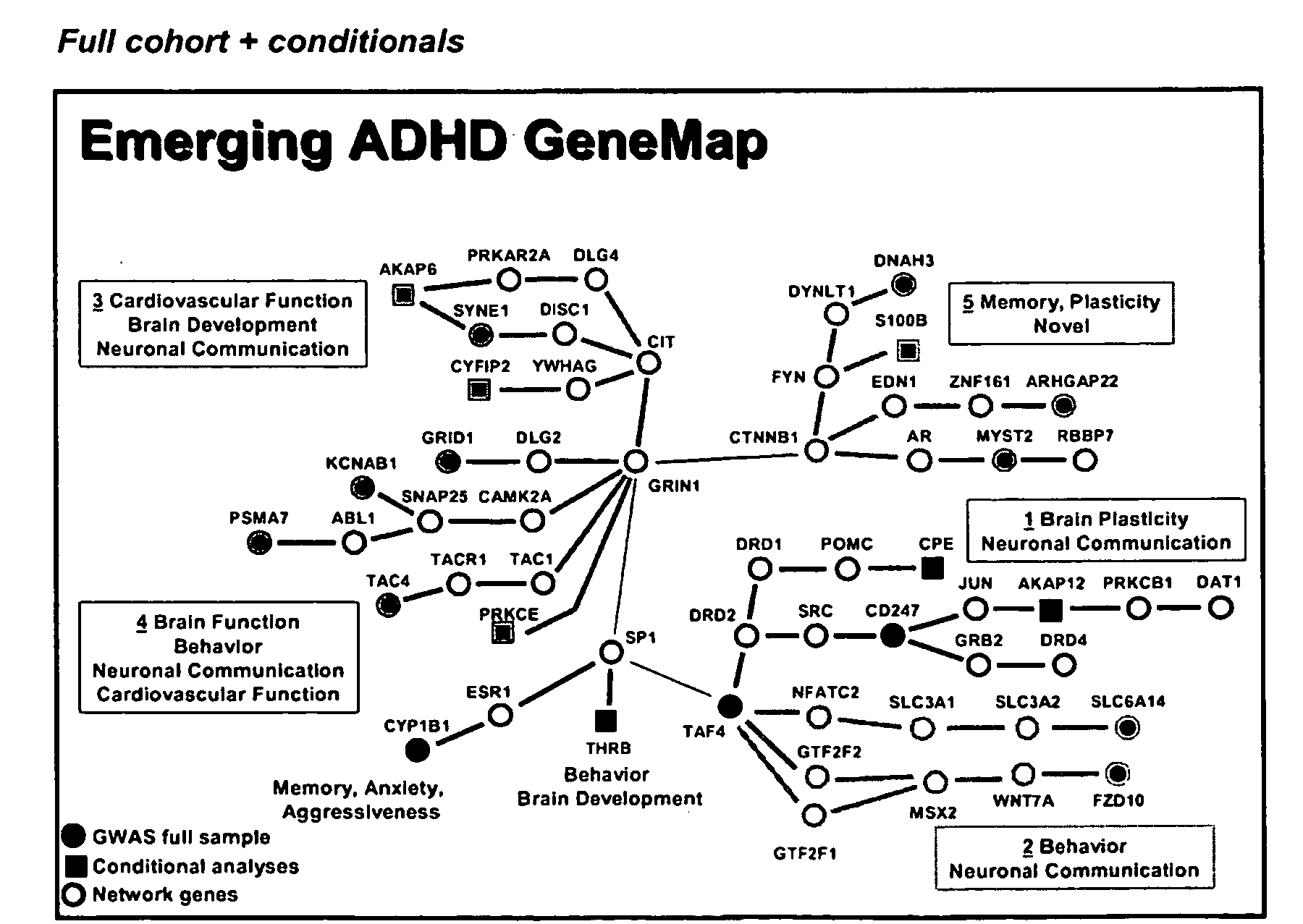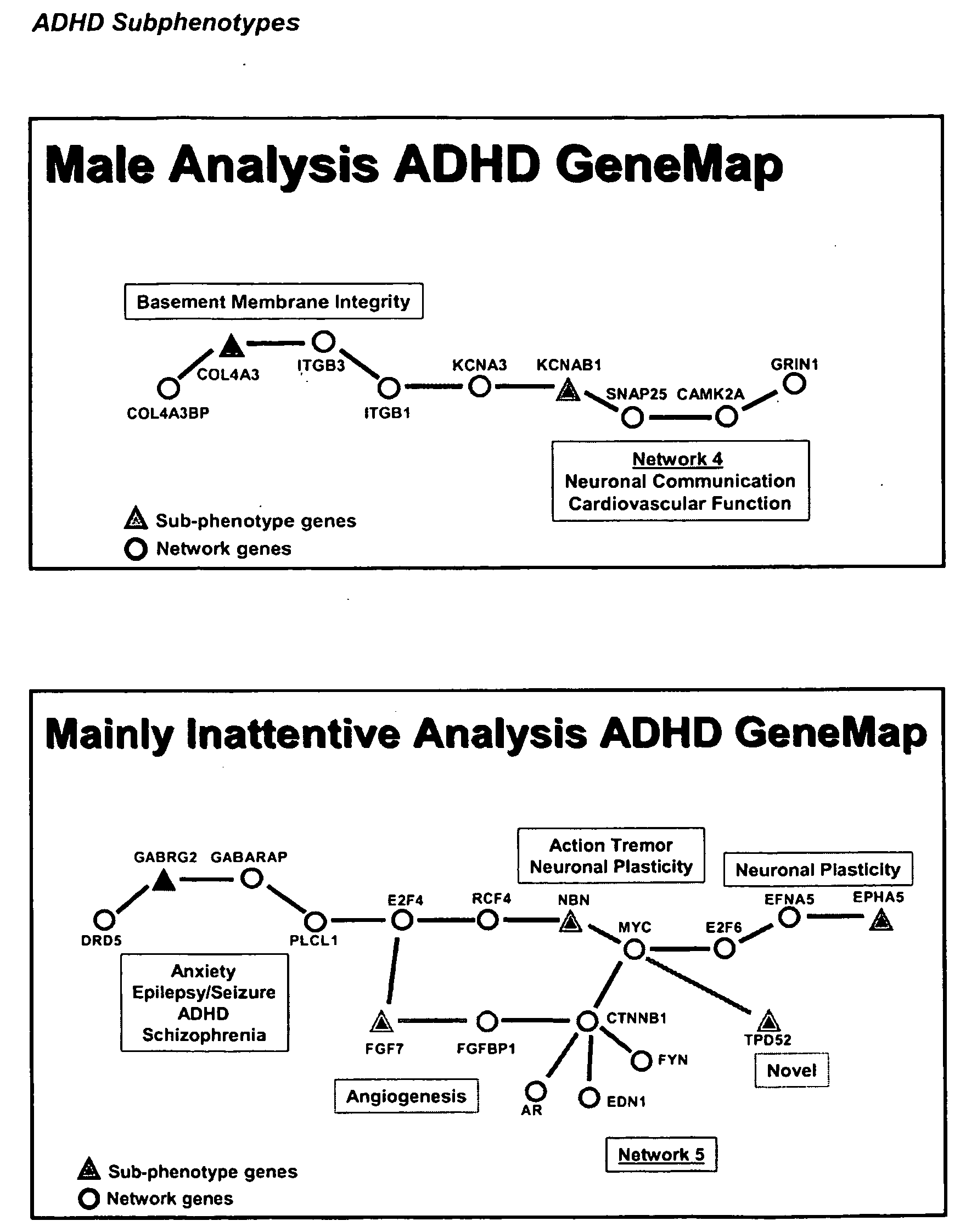Genemap of the human genes associated with adhd
a human gene and gene mapping technology, applied in the field of gene mapping of human genes associated with adhd, can solve the problems of higher risk of substance abuse and oppositional defiant behavior, higher frequency of school failures of adhd subjects, and learning disorders
- Summary
- Abstract
- Description
- Claims
- Application Information
AI Technical Summary
Benefits of technology
Problems solved by technology
Method used
Image
Examples
example 1
Identification of Cases and Controls
[0402]All individuals were sampled from the Quebec founder population (QFP). Membership in the founder population was defined as having four grandparents of the affected child having French Canadian family names and being born in the Province of Quebec, Canada or in adjacent areas of the Provinces of New Brunswick and Ontario or in New England or New York State. The Quebec founder population is expected to have two distinct advantages over general populations for LD mapping: 1) increased LD resulting from a limited number of generations since the founding of the population and 2) increased genetic alleic homogeneity because of the restricted number of founders (estited 2600 effective founders, Charbonneau et al. 1987). Reduced allelic heterogeneity will act to increase relative risk imparted by the remaining alleles and so increase the power of case / control studies to detect genes and gene alleles involved in complex disorders within the Quebec po...
example 2
Genome Wide Association
[0405]Genotyping was performed using the QLDM-Max SNP map using IIlumina's Infinium-II technology Single Sample Beadchips. The QLDM-Max map contains 374,187 SNPs. The SNPs are contained in the Illumina HumanHap-300 arrays plus two custom SNP sets of approximately 30,000 markers each. The HumanHap-300 chip includes 317,503 tag SNPs derived from the Phase I HapMap data. The additional (approx.) 60,000 SNPs were selected by to optimize the density of the marker map across the genome matching the LD pattern in the Quebec Founder Population, as established from previous studies at Genizon, and to fill gaps in the Illumina HumanHap-300 map. The SNPs were genotyped on the 459 trios for a total of ˜515,255,499 genotypes.
[0406]The genotyping information was entered into a Unified Genotype Database (a proprietary database under development) from which it was accessed using custom-built programs for export to the genetic analysis pipeline. Analyses of these genotypes wer...
example 3
[0407]1. Dataset Quality Assessment
[0408]Prior to performing any analysis, the dataset from the GWS was verified for completeness of the trios. The programs FamCheck and FamPull removed any trios with abnormal family structure or missing individuals (e.g. trios without a proband, duos, singletons, etc.), and calculated the total number of complete trios in the dataset. The trios were also tested to make sure that no subjects within the cohort were related more closely than second cousins (6 meiotic steps).
[0409]Subsequently, the program DataCheck2.1 was used to calculate the following statistics per marker and per family:
[0410]Minor allele frequency (MAF) for each marker; Missing values for each marker and family; Hardy Weinberg Equilibrium for each marker; and Mendelian segregation error rate.
[0411]The following acceptance criteria were applied for internal analysis purposes:
[0412]MAF>4%;
[0413]Missing values <1%;
[0414]Observed non-Mendelian segregation<0.33%;
[0415]N...
PUM
| Property | Measurement | Unit |
|---|---|---|
| degrees of freedom | aaaaa | aaaaa |
| polymorphic | aaaaa | aaaaa |
| frequency | aaaaa | aaaaa |
Abstract
Description
Claims
Application Information
 Login to View More
Login to View More - R&D
- Intellectual Property
- Life Sciences
- Materials
- Tech Scout
- Unparalleled Data Quality
- Higher Quality Content
- 60% Fewer Hallucinations
Browse by: Latest US Patents, China's latest patents, Technical Efficacy Thesaurus, Application Domain, Technology Topic, Popular Technical Reports.
© 2025 PatSnap. All rights reserved.Legal|Privacy policy|Modern Slavery Act Transparency Statement|Sitemap|About US| Contact US: help@patsnap.com


